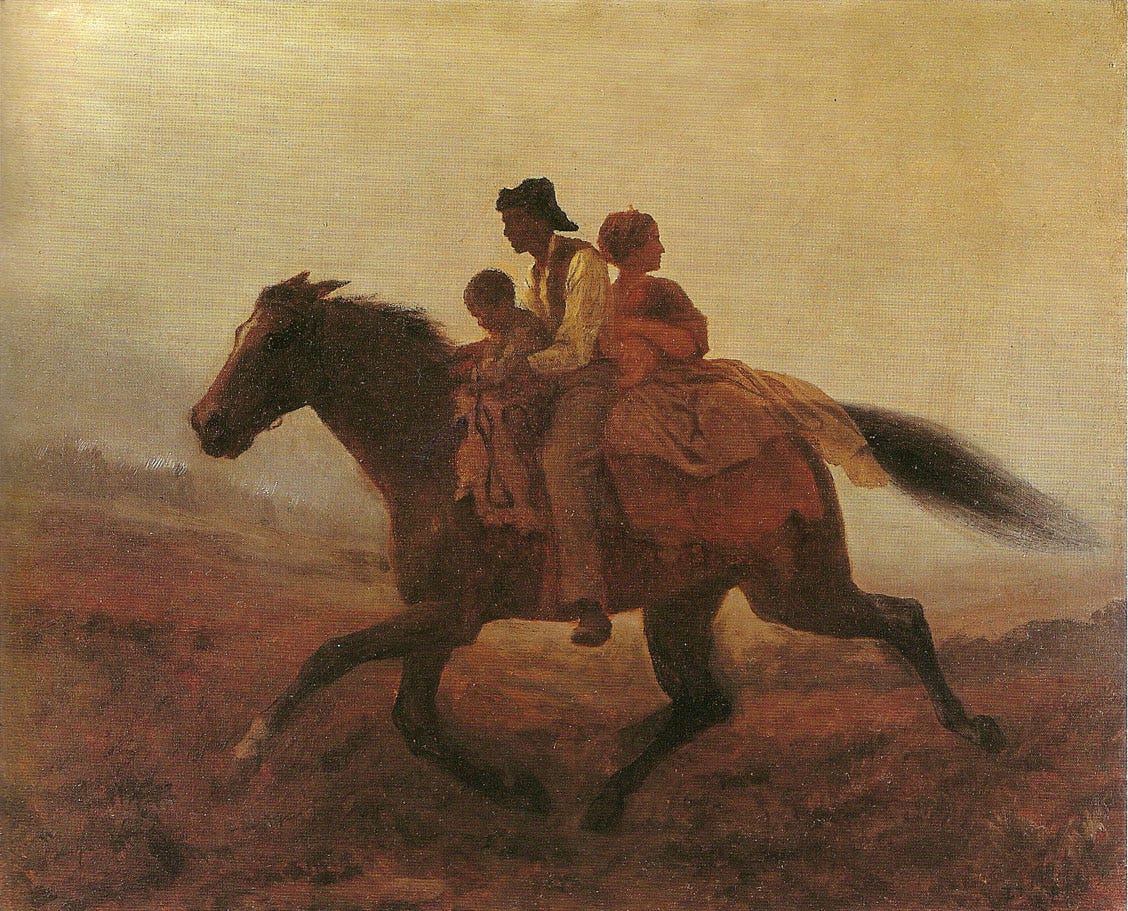Irish Immigrants and the Underground Railroad
Medium
2015-07-02
Liam Hogan

A Ride for Liberty — The Fugitive Slaves, oil on paperboard, ca. 1862, Brooklyn Museum |
But the Irish are indeed a strange people. How varied their aspect — how contradictory their character.
William Wells Brown (1852)
What William Wells Brown should have said was “the Irish are human.”
The sad history of anti-black violence perpetrated by some Irish immigrants in the United States is well known. This was often the abominable product of racism, political self-interest, craven leadership and labour competition. While these incidents, such as the New York Draft riots (1863) or the Memphis massacre (1866), were committed by a fraction of Irish immigrants who settled in the United States, they have certainly cast a long shadow over the historical relationship between the Irish-American and African-American communities. Some Irish were also active in disrupting the activities of the Underground Railroad. See the famous case of the self-emancipated slave Anthony Burns who was arrested under the Fugitive Slave Law in 1854 and held in custody in Boston. When a group of African Americans and white anti-slavery activists attempted to rescue him by force, it was an Irish militia which suppressed their advances. One of their deputised number was stabbed and killed during the altercation. When African Americans held a vigil before Burns was sent back to his owners they were subjected to the “jeers and insults of pro-slavery Irishmen.” Sojourner Truth witnessed how Burns was marched on to the ship, a solitary figure, under the armed guard of two thousand armed white men. Some of those in the crowd, likely to be Irish-Americans, cheered at this pathetic procession. They also pointed at prominent abolitionists in the crowd, shouting “there go [the] murderers” of an Irish labourer. The historian Noel Ignatiev has described the actions of the Boston Irish militia as being evidence that the Irish were “the Swiss Guards of the Slave Power.”
William Still included an account of a group of Irishmen who attacked fugitive slaves in his seminal work The Underground Railroad, A Record (1872) According to his correspondent, these Irish attackers were either a group of slave-catchers following up on a bounty or racist thugs looking to attack African Americans as part of their Halloween entertainment. Either way, they got more than they bargained for…
…Perhaps it is for these reasons that the role of a number of Irish immigrants in helping slaves escape their bondage has been overlooked. It helps to explain why the cordial relationships and marriages, although the latter were relatively rare, between Irish immigrants and African Americans in the early nineteenth century have been mostly forgotten. This complex relationship is illustrated well by Frederick Douglass’ guarded reaction to two sympathetic Irish labourers in Baltimore…
…Who were these Irish born “conductors”?
Because of the nature of this surreptitious activity, attempts to verify what actually happened are often difficult, if not impossible. While it may make the academic historian wince, this history generally relies on oral tradition. From the few names I have found, it seems that the Irish immigrants who supported the Underground Railroad were mostly middle class, some were Presbyterian, others were Catholic, and a majority hailed from Ulster. The class aspect is not a surprise as it mirrors the general make up of the anti-slavery movement in Ireland in the late eighteenth to mid-nineteenth century. The following list is far from exhaustive, so please get in touch if you know of more individuals from Ireland who were involved…
…Name: Mary Weaver
From: Ireland
Location of UR Activity: Richmond, Virginia
Narrative: The remarkable story of Mary Weaver is recounted by William Still. Mary Weaver and John Hall, a slave, fell in love and wished to marry. Hall was the property of a slave owner named John Dunlap but he singled out his prior owner, a man named Burke, as being especially cruel. Both of these men might also have been Irish. Mary then proceeded to save money and make arrangements to pay for his escape via the Underground Railroad to Canada. She later joined him there and the two were soon married.
“[Hall] was also under the influence and advice of a daughter of old Ireland. She was heart and soul with John in all his plans which looked Canada-ward. It is very certain, that this Irish girl was not annoyed by the kinks in John’s hair. Nor was she overly fastidious about the small percentage of colored blood visible in John’s complexion. It was, however, a strange occurrence and very hard to understand. Not a stone was left unturned until John was safely on the Underground Rail Road. Doubtless she helped to earn the money which was paid for his passage. And when he was safe off, it is not too much to say, that John was not a whit more delighted than was his intended Irish lassie, Mary Weaver. John had no sooner reached Canada than Mary’s heart was there too.”
“Circumstances, however, required that she should remain in Richmond a number of months for the purpose of winding up some of her affairs. As soon as the way opened for her, she followed him. It was quite manifest, that she had not let a single opportunity slide, but seized the first chance and arrived partly by means of the Underground Rail Road and partly by the regular train. Many difficulties were surmounted before and after leaving Richmond, by which they earned their merited success. From Canada, where they anticipated entering upon the matrimonial career with mutual satisfaction, it seemed to afford them great pleasure to write back frequently, expressing their heartfelt gratitude for assistance, and their happiness in the prospect of being united under the favorable auspices of freedom!”…
Read the entire article here.




